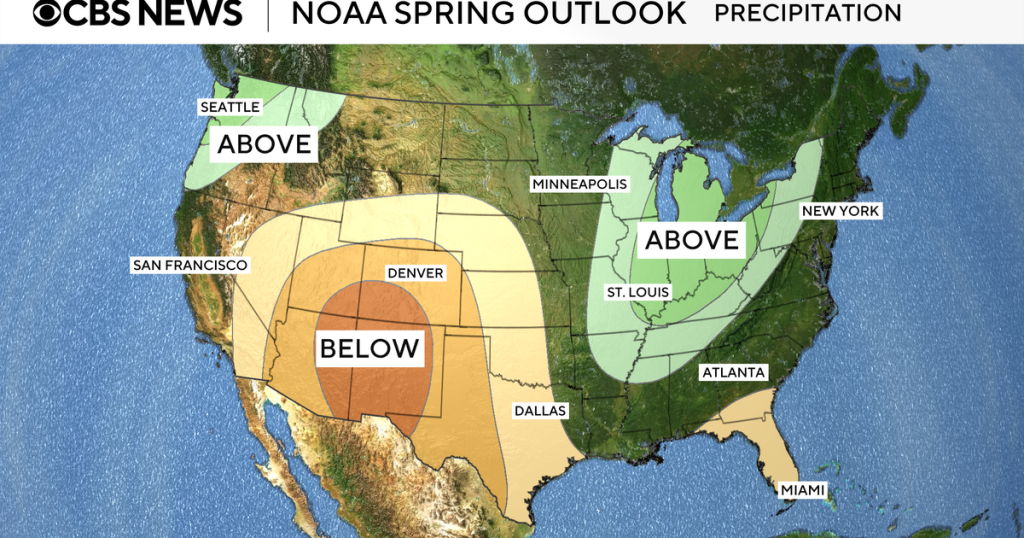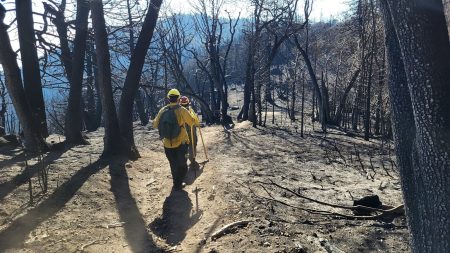NOAA’s 2025 Spring Outlook: A Look at Temperature, Precipitation, and Drought Patterns
As meteorological winter comes to a close, the National Oceanic and Atmospheric Administration’s (NOAA) Climate Prediction Center has released its three-month weather outlook for meteorological spring, which runs from March through May. This forecast provides insights into expected temperature, precipitation, and drought conditions across the United States. With La Niña conditions still influencing weather patterns, the spring of 2025 is expected to bring a mix of warmer temperatures, shifting precipitation patterns, and persistent droughts in certain regions.
Temperature Outlook: Warmer Than Average for Most of the Country
The temperature outlook for spring 2025 indicates that much of the United States will experience warmer-than-average temperatures. The Desert Southwest and Southern Tier are expected to see the most significant increases in temperature, with above-average warmth extending into the Northeast and New England. This trend aligns with broader climate patterns, where rising global temperatures are contributing to warmer springs across many parts of the country. However, the far Northwest is an exception, with below-average temperatures forecasted for the region. This cooler condition could be attributed to lingering winter influences or regional weather systems.
Precipitation Outlook: Drier Conditions in the Southwest, Wetter in the Midwest and Northwest
The precipitation forecast for spring 2025 paints a stark picture of contrasting conditions across the country. The Southwest, Southern Rockies, and Southern Plains are expected to experience well-below-average rainfall and snow accumulation, exacerbating dry conditions in these already water-stressed regions. Similarly, parts of Florida and southern Georgia are predicted to see drier-than-normal conditions, which could worsen droughts in these areas.
In contrast, the Ohio Valley and Great Lakes region are forecasted to receive above-average precipitation, with frequent rain and snow showers. This increase in moisture could lead to more frequent "clipper systems" and lake-effect snow events, particularly in the Midwest and Great Lakes. The far Northwest is also expected to see above-average precipitation, with incoming weather systems bringing rain and snow to the region. These wetter conditions could provide some relief to areas that have been impacted by recent droughts.
Drought Outlook: Persistence and Expansion of Dry Conditions
The drought outlook for spring 2025 suggests that dry conditions will persist in several parts of the country. The Northern Plains and Southwest, which have already been grappling with drought, are expected to see these conditions continue through the spring. Additionally, new drought developments are likely in parts of the Southern Plains and Florida, where below-average precipitation and warmer temperatures will further strain water resources.
On a more positive note, the Great Lakes region and parts of interior New England may see small improvements in drought conditions due to above-average precipitation. However, these improvements are expected to be limited in scope and may not significantly alter the overall drought landscape. Overall, the drought outlook for spring 2025 remains concerning, with little relief expected for many drought-affected areas.
Regional Weather Extremes: What to Expect This Spring
The spring of 2025 is expected to bring a mix of weather extremes across different regions. In the Desert Southwest and Southern Tier, the combination of warmer-than-average temperatures and below-average precipitation could exacerbate wildfire risks and water shortages. Meanwhile, the Midwest and Great Lakes region could experience more frequent and intense snowstorms, potentially disrupting daily life and transportation.
In the Northwest, cooler-than-average temperatures and above-average precipitation could lead to a prolonged winter feel, with increased snowfall and rain. This could be beneficial for areas that rely on snowpack for water supply but may also pose challenges for agriculture and outdoor activities. Florida and southern Georgia, on the other hand, may face heightened risks of wildfires and crop stress due to drier conditions.
Conclusion: Preparing for a Spring of Weather Extremes
NOAA’s spring 2025 outlook highlights the growing influence of climate variability on seasonal weather patterns. With warmer temperatures, shifting precipitation patterns, and persistent droughts, this spring is expected to bring a mix of challenges and opportunities across the United States. Understanding these forecasts can help communities prepare for potential weather extremes, from drought management in the Southwest to snowstorm readiness in the Midwest. As La Niña conditions continue to shape weather patterns, staying informed and adaptive will be key to navigating the uncertainties of spring 2025.















